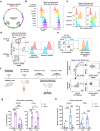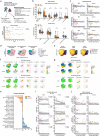This is a preprint.
Single-cell quantification of the microbiota by flow cytometry: MicFLY
- PMID: 41000908
- PMCID: PMC12458334
- DOI: 10.1101/2025.09.18.677130
Single-cell quantification of the microbiota by flow cytometry: MicFLY
Abstract
The intestinal microbiota regulates multiple host functions, including digestion and immune development. Our knowledge of the microbiota has been shaped by available technology that primarily measures relative abundance. However, understanding the basis of shifts in microbiota composition requires single cell, absolute abundance measurements. In response to this problem, we developed Microbiota Flow Cytometry (MicFLY), a single cell technology that directly quantifies and characterizes total bacterial abundances with species-level resolution in the microbiota. Using MicFLY, we can identify all major intestinal taxa, discriminate live from dead bacteria, perform single cell measurements of heterogeneous bacterial mRNA expression and concurrently quantify Immunoglobulin (Ig) A and G binding to intestinal bacteria. Using longitudinal species-resolved, quantitative analysis of the preterm infant microbiota, we identify that E. coli unbound by IgG and IgA associates with the development of necrotizing enterocolitis. The application of MicFLY single cell technology permits measurement of the microbiota at a finer scale and with deeper mechanistic understanding of compositional changes.
Conflict of interest statement
DECLARATION OF INTERESTS TWH, CMT, DAA and WHD have patents on the MicFLY technology in this manuscript. TWH previously consulted for Keller Postman LLC.
Figures





References
-
- Gopalakrishna K.P., Macadangdang B.R., Rogers M.B., Tometich J.T., Firek B.A., Baker R., Ji J., Burr A.H.P., Ma C., Good M., et al. (2019). Maternal IgA protects against the development of necrotizing enterocolitis in preterm infants. Nat Med 25, 1110–1115. 10.1038/s41591-019-0480-9. - DOI - PMC - PubMed
-
- Ley R.E., Bäckhed F., Turnbaugh P., Lozupone C.A., Knight R.D., and Gordon J.I. (2005). Obesity alters gut microbial ecology. Proceedings of the National Academy of Sciences 102, 11070–11075. doi: 10.1073/pnas.0504978102. - DOI
Publication types
Grants and funding
LinkOut - more resources
Full Text Sources
Miscellaneous
